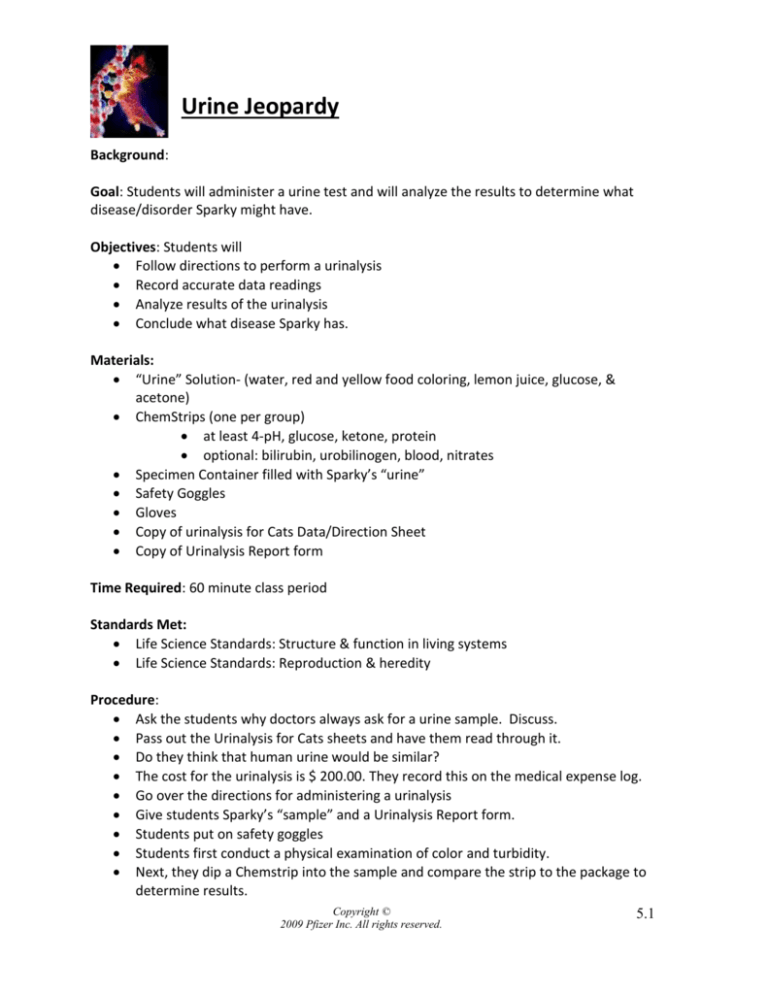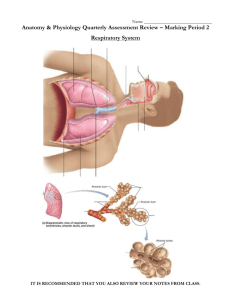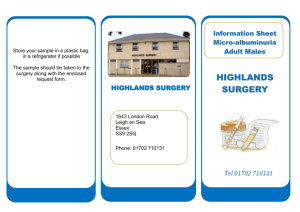
Urine Jeopardy
Background:
Goal: Students will administer a urine test and will analyze the results to determine what
disease/disorder Sparky might have.
Objectives: Students will
Follow directions to perform a urinalysis
Record accurate data readings
Analyze results of the urinalysis
Conclude what disease Sparky has.
Materials:
“Urine” Solution- (water, red and yellow food coloring, lemon juice, glucose, &
acetone)
ChemStrips (one per group)
at least 4-pH, glucose, ketone, protein
optional: bilirubin, urobilinogen, blood, nitrates
Specimen Container filled with Sparky’s “urine”
Safety Goggles
Gloves
Copy of urinalysis for Cats Data/Direction Sheet
Copy of Urinalysis Report form
Time Required: 60 minute class period
Standards Met:
Life Science Standards: Structure & function in living systems
Life Science Standards: Reproduction & heredity
Procedure:
Ask the students why doctors always ask for a urine sample. Discuss.
Pass out the Urinalysis for Cats sheets and have them read through it.
Do they think that human urine would be similar?
The cost for the urinalysis is $ 200.00. They record this on the medical expense log.
Go over the directions for administering a urinalysis
Give students Sparky’s “sample” and a Urinalysis Report form.
Students put on safety goggles
Students first conduct a physical examination of color and turbidity.
Next, they dip a Chemstrip into the sample and compare the strip to the package to
determine results.
Copyright ©
2009 Pfizer Inc. All rights reserved.
5.1
After clean up, students analyze the results and determine what diseases/disorders
Sparky has.
Give groups their medical files. Students go back to their Disease/Disorder
Information Sheets and fill in test results.
Fill in Final Treatment form
Assessment:
Participation in urinalysis lab
Accurate documentation of urine results
Accurate conclusion of Diabetes Mellitus
Completion of Disease/Disorder Information Sheets
Prep:
Stock Urine Solution (normal)
2000ml water
1 drop yellow food coloring
1 drop red food coloring (this should appear straw colored)
Check the pH. It should be around a 6. Add a few drops of HCl or vinegar to lower it.
Diabetes Mellitus (Sparky’s Urine)
Take 300ml of stock solution
Add:
700 ml of water
6 ml corn syrup or 60 grams of glucose
1 or 2 ml of acetone (which is a ketone)
Bring pH closer to 5 or 6 by adding HCl or vinegar
Add more food coloring if necessary to make it appear amber-yellow
Check your solution several times. It should be positive for glucose, be slightly positive for
ketones, negative for protein and have a pH of about 5.5 or 6.
____________________________________________________________________
Before class, pour some of the “urine” into specimen cups and cover. Label the cups
Copyright ©
2009 Pfizer Inc. All rights reserved.
5.2
Urine Jeopardy: Lab Procedure Sheet
Record all observations on the Urinalysis Report Form
Color and TurbidityProcedure1. Observe the specimen
Normal urine is amber-yellow and clear to slightly cloudy
o Concentrated urine is darker yellow.
o Dilute urine is colorless.
o White blood cells may make the urine cloudy.
o Blood in the urine can give a red-brown tinge.
Chemical AnalysisProcedure1. Dip a chemstrip into the urine sample for a few seconds
2. Remove the chemstrip.
3. Wait two minutes
4. Compare the chemstrip to the color chart
pH-
This number shows how acidic or alkaline the urine is.
Normal pH- 5.5 – 7.0
Higher pH levels can be a sign of infection
Protein-Healthy animals usually do no have protein in their urine. Protein can
be an indication of kidney problems.
Glucose-Normal urine does not have glucose. Glucose is a positive indicator for
diabetes.
Ketones-Ketones are substances formed during fat breakdown. Ketones can be
found in cases of starvation and diabetes. Normal urine has no ketones.
Copyright ©
2009 Pfizer Inc. All rights reserved.
5.3
Optional Tests:
Bilirubin- Bilirubin can show liver disease. It is a pigment made in the liver from
dead red blood cells. Normal readings are negative.
Urobilinogen- Normal results show small amounts of urobilinogen. It is
produced by intestinal bacteria.
Blood- Small amounts of blood in the urine is normal. Large amounts can be due
to trauma, urinary tract infections and blood clotting problems.
Nitrates- Produced by bacteria during infections. Normal readings are negative
Copyright ©
2009 Pfizer Inc. All rights reserved.
5.4
Urine Jeopardy: Urinalysis Report Form
Patient Name _________________________ Age _______ Sex __________
Veterinary Assistants
Physical Examination
colorless yellow amber
Color:
Appearance:
clear
hazy
4
6
other
cloudy
turbid
Chemical Analysis
pH
(circle one)
5
7
(circle one)
8
9
10
11
Results
Protein
Negative
Positive
___________
Glucose
Negative
Positive
___________
Ketones
Negative
Positive
___________
Copyright ©
2009 Pfizer Inc. All rights reserved.
5.5
Urine Jeopardy: Urinalysis For Cats
Color/turbidity: Normal urine is amber-yellow in color and clear to slightly cloudy. Concentrated
urine is a darker yellow. Dilute urine may be colorless. White blood cells may make the urine cloudy.
Blood in the urine can give a red-brown tinge.
Chemical analysis: Many chemical tests can be performed on a small quantity of urine by using a
dipstick. A dipstick is a piece of plastic to which pads of certain chemical reagents have been
attached. Each pad will test for a particular substance in the urine. When the urine comes in contact
with the reagents, a chemical reaction occurs which changes the color of the pad based upon how
much of the substance is in the urine. The color of the pad is compared to a color chart and an
approximate amount of the substance can be determined.
Urine pH – This number is a reading of how acidic or alkaline the urine is. On a pH scale of 1-14, 7 is
considered neutral, meaning neither acid nor alkaline. A number less than 7 indicates acidity, while a
number greater than 7 indicates alkalinity. It is the pH of the patient's urine that is being measured
in a urinalysis, not the pH of the food the patient has eaten. Most normal dogs and cats have a urine
pH of 5.5 to 7.0; however, some normal pets may have higher or lower values.
Protein – Healthy animals will usually not have any protein in their urine, although in some cases
small, trace amounts may be normal. The significance of any protein in the urine is dependent upon
the specific gravity of the sample. Small amounts of protein are more significant in dilute urine.
Glucose – If the glucose (sugar) in the blood is significantly higher than normal, (for example, in
diabetes) some of the excess will be found in the urine. Normal dog and cat urine should be negative
for glucose.
Ketones – Ketones are substances formed in the body during the breakdown of lipids (fat). Ketones
may be found in cases of starvation, in some diabetic patients, and in certain other diseases. Normal
dog and cat urine should be negative for ketones.
Optional Tests
Bilirubin – Bilirubin is a pigment made by the liver from dead or dying red blood cells.. Bilirubin in the urine of
a cat is a concern and calls for further investigation. High amounts of bilirubin in the urine can be a sign of liver
disease, bile duct obstruction, or abnormal destruction of red blood cells (hemolysis).
Urobilinogen – This is a compound formed from bilirubin by intestinal bacteria. Normal cats and dogs have
small amounts of urobilinogen in their urine. This is a common test that is included on many dipsticks, but the
results are not considered very accurate in cats and dogs, and are difficult to interpret.
Blood – Healthy dogs and cats may have a few red blood cells in their urine, but greater than normal amounts
indicate a problem. Blood in the urine (hematuria) can be due to a number of causes, including trauma,
urinary tract infection, bladder stones, and blood clotting problems.
Nitrites – Nitrites may be produced by the bacteria present in some infections.
Copyright ©
2009 Pfizer Inc. All rights reserved.
5.6








